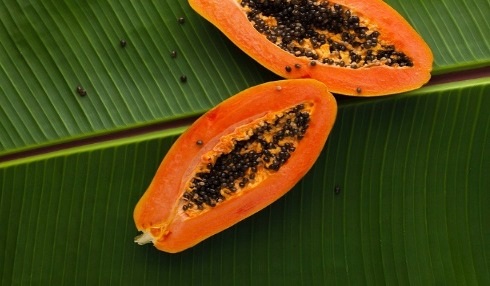
Is Papaya Good For Diabetics? – Can People With Diabetes Eat Papaya?
Yes! Papaya is a safe fruit to eat even if you’re diabetic. Both patients with diabetics and heart disease can eat papaya as it’s rich in flavonoids and can help lower blood glucose levels.
Fruits are naturally sweet but eating sugar increases blood sugar levels, some individuals may believe that fruits should be avoided. However, fruit is truly a nutritious part of a balance diet and can be consumed in moderation.
What is Diabetes?
Diabetes is a condition in which the body either doesn’t produce enough (or any) insulin or uses it improperly. A hormone called insulin facilitates the entry of glucose, or sugar, into the body’s cells. Sugar might build up in your blood if your body is unable to effectively produce or utilize insulin.
While some people manage high blood sugar with medicine, others do it by engaging in regular exercise and eating a balanced diet.
Is Papaya Good For Diabetes?
Papaya can be an excellent choice for those who have diabetes. Due to its mild Glycemic index, Papaya consumption may also help maintain blood sugar.
Although papaya contains sugar, it is also a good source of vitamins like vitamin C, magnesium, potassium, and dietary fiber.
One reason it’s vital to be mindful of portion size is that a medium-sized papaya has roughly 11 grams of sugar. while consuming papaya. Knowing nutrition is key to understanding how food impacts the body. For example, vitamins are not only necessary for maintaining overall health but can also help control blood sugar levels.
For instance, because it is involved in transforming food into energy, magnesium is a mineral that is necessary for normal energy-producing metabolism. Additionally, it maintains strong bones and helps control blood pressure!
Papaya For Diabetes
Papaya has a medium (60) glycemic index, which means that it does not cause a sharp increase in blood sugar levels. Additionally, papaya contains the naturally occurring antioxidants flavonoids and lycopene.
Nutritional Profile of Papaya
Considering that papaya contains the following nutrients per 100 grams:
| Calories. | 32 |
| Proteins | 0.6 grams |
| Fats | 0.1 grams |
| Fibres | 2.6 grams |
| Carbohydrates | 7.2 grams |
| Vitamin C | 157% of RDI |
| Vitamin A | 33% of RDI |
| Folate (Vitamin B9) | 14% of RDI |
| Potassium | 11% of RDI |
What are the benefits of eating papaya?
Increasing your intake of fruits and vegetables can keep you healthy and lower your risk of contracting some chronic diseases.
The risk of heart disease, stroke, high blood pressure, type 2 diabetes, and several malignancies is decreased by eating a diet high in fruits and vegetables.
Papaya consumption can lower blood sugar levels, primarily via enhancing digestion. Omega-3 fatty acids, vitamin C, and potassium are also found in papaya. In order to lessen the negative impacts of diabetes, such as the detrimental effects on food, people with diabetes should lower their dependency on insulin while maintaining a healthy lifestyle.
Is Papaya Good For Diabetics – Good Immune booster
One papaya has 200% of the recommended daily allowance of vitamin C. Collagen, which aids in the binding of human tissues, is produced only when vitamin C is present. It aids in the prevention of a variety of illnesses, including scurvy anemia, poor skin issues, and gum disease. Papaya should be consumed daily as it will help to slow down medical issues.
Papaya contains fiber – Is Papaya Good For Diabetes?
The fiber in papaya is vital for our digestive systems. Considering that fibers are broken down by the body, fiber won’t cause blood sugar to rise.
It’s healthy – Is Papaya Good For Diabetics?
Folic acid, vitamins A, B, and E, magnesium, copper, potassium, and beta-carotene are all present in papaya. They have sufficient antioxidants, which stop plaque from forming in your arteries. Papaya improves kidney performance by keeping uric acid stable. Additionally, it promotes cell regeneration, which is particularly advantageous because diabetes can harm the nerves. Additionally, it includes flavonoids, which research suggests may help reduce blood sugar levels.
Keeps you full – Is Papaya Good For Diabetes?
When your gut is digesting sugar there is need to slow down your appetite. it will help prevent eating unhealthy foods that maybe dangerous for diabetes. Papaya is a large fruit that is very full and suppresses your craving.
Helps in digestion – Is Papaya Good For Diabetics?
Papaya is helpful in reducing constipation and promoting a healthy bowel because it is high in fiber and water. Papain, an enzyme that aids in digestion, is also present.
Low glycemic index- Is Papaya Good For Diabetics?
Fructose, a kind of sugar found in papaya, can be harmful if consumed in excess. Papaya has a low glycemic index, so it won’t cause your blood sugar to spike.
Other Health Benefits of Papaya
The “fruit of angels,” papaya, is helpful in treating a variety of diseases and conditions.
- Antioxidants like lycopene are abundant in papaya. High levels of antioxidants aid in reducing cholesterol oxidation, hence preventing heart blockages.
- Treats diabetes, heart conditions, indigestion, dengue, cancer, arthritis, and a variety of other illnesses.
These are the 2 key reasons why diabetics should eat ripe papaya.
Substitutes to Consuming Papaya – Papaya Alternative
In place of papaya, a number of fruits can be consumed such as.
- Apples
- Blackberries
- Blueberries
- Strawberries
- Grapefruit
- Cranberries
- Pears
- Plums
- Raspberries
- Apricots
- Pomegranates
- Guavas
- Cherries
- Watermelon is rich potassium, aids proper functioning of the kidney, which is a major concern for people with diabetes.
What is the best time to eat papaya?
Because papaya has a medium Glycemic index, it is preferable to eat paw paw in the mid-afternoon or at midday.Fruits should be avoided for about 2-4 hours after meals.
Despite the moderate sugar content of papaya, it is not advisable to eat papaya at night.
Ways to Eat Papaya for People With Diabetes
- Eat papaya as a fruit when it is ripe.
- Prepare fruit juice using ripe papaya.
- Use ripe papaya to make smoothies
- Toss into a fruit salad using ripe papaya, apple, watermelon.
- Papaya and avocado may be cut into cubes, mixed with diced cooked chicken, using olive oil and vinegar as a salad dressing.
Side Effect or Risks of Excessive Consumption of Papaya
Despite how tempting it might be, don’t eat too many papayas. One cup per day is the recommended serving for diabetes patients.
Papaya intake in excess might raise blood sugar levels. Due to papaya’s laxative properties, over eating may also cause diarrhea.
Read Also >>>>> Can Diabetics Eat Popcorn? -Popcorn And Diabetes
Frequently Asked Questions
What is the glycemic index of papaya?
Papayas, with a glycemic index of 60, are considered moderate GI fruits. Papaya’s low glycemic index is ideal for limiting the unexpected spike in blood sugar levels. Fruits with a moderate glycemic index (GI) fall between 50 and 69. Fruits with a GI index of 20 to 49 fall into the low GI group, whereas those with a GI index of 70 to 100 are categorized as high GI foods.
Is papaya high in sugar?
Natural sugar in papaya are not abundant. A little papaya can be easily sliced into pieces and fed to a diabetic individual.
Is papaya good for diabetes type 2?
Given that papaya has a medium GI, it can be a viable option for persons with type 2 diabetes. It also has a lot of fiber. This means that it can lower blood sugar levels in the body and make a person feel fuller for a longer period of time. Additionally, it includes flavonoids and natural antioxidants that have a substantial impact on naturally lowering blood sugar levels.
Does papaya raise blood sugar?
Papaya has a glycemic index of 60. It might not significantly raise blood sugar levels. To determine how much your blood sugars are rising after eating papaya, it is always a good idea to check your blood sugar levels before and afterward. The benefits of papayas would greatly offset the increase in sugars. You may always take steps to ensure that your intake is moderate.
Can diabetics eat papaya daily?
Although papaya is low in calories, doctors and nutritionists recommend diabetes patients to limit their daily intake to one cup since the fruit should not be consumed in excess because it naturally contains a reasonable quantity of organic sugars.
How much papaya can a diabetic eat?
Papaya has the ideal glycemic index for a diabetic diet, but it must be consumed in the proper amounts. Consuming papaya in greater quantities than necessary can result in problems like asthma. Experts recommend consuming one cup of papaya each day (not more than 4 thin slices).
What is papaya good for?
Papayas are the ideal fruit for regulating blood sugar levels because of their low glycemic index. Along with helping to manage diabetes, papaya also helps to prevent heart disease, improve digestion, nourish the skin, lessen menstrual discomfort and stress, among other health benefits. It also offers other health advantages, but in order to profit from them, you must take it in the proper amounts.
Is raw papaya good for diabetes?
Yes, eating raw papaya is beneficial for managing diabetes. It is perfect for diabetics because it is low in sugar and high in fiber. Additionally, papaya is a rich source of nutrients and vitamins that our bodies need. Papaya has a lot of antioxidants and many other health advantages.
Is Papaya leaf good for diabetes?
Yes, papaya leaves are helpful for diabetes, just like papaya seeds are. Potential antioxidants found in papaya leaf are crucial for preserving healthy health. Additionally, research indicates that papaya leaves might lower blood sugar levels, making them an ideal fruit for diabetics.
Are Papaya seeds good for Diabetes?
Yes, as flavonoids, a powerful antioxidant with a low glycemic index, are abundant in papaya seeds. Avoid consuming papaya seeds in excess, though, as they can cause problems. Additionally, papaya seeds shouldn’t be consumed in excess by breastfeeding mothers. Sugar levels won’t rise if you eat the proper amount.
Is papaya good for cholesterol?
Yes! Papaya’s potassium, vitamin C content, and fiber all aid to maintain healthy arteries, which improves blood flow. The body’s cholesterol levels are known to decrease as a result of the enhanced circulation, which lowers the risk of stroke and heart disease.



